Introduction
When an organization determines what it will pay for salaries and wages, it is necessary to understand the legislative requirements, the volume of potential employees, and the economic condition of the environment in which it operates. When finding out what to pay, the organization has to first consider the placement of the role in the workplace. This can be determined by evaluating or classifying the job. Secondly, the organization has to consider the relevant job experience and skills the applicant possesses (Fox & Donohue, 2008). Job analysis is an important process in an organization of any size. Notably, job duties and responsibilities, work assignments, and the organization structure are subject to change hence the need for Job Analysis. The job supervisor initiates the job analysis request. When there is a significant change in the duties of an existing job or establishment of a new job, the supervisor concerned with the activities will initiate a" Request for Job Analysis" form. He or she will then submit the form through appropriate channels to the Department Head responsible for the activity (Thomas, 2015). In this request, the job supervisor outlines the principal revisions or the main duties of the new job.
Upon receiving the "Request for Job Analysis" form, the Department Head concerned reviews the request to ensure that it is valid. After the review process, the form is forwarded to the Huma Resources Department where further actions are taken. Before approving the job analysis request, the Human Resource Management ensures that job is in conformity with the approved organization chart. To ensure that the job analysis is conducted appropriately, various measures have to be put in place. First, it is necessary to plan for the job analysis before gathering data from employees and managers. Second, it is crucial that preparations and introduction of the job analysis be done. For instance, are the jobs to be analyzed clerical jobs, hourly jobs, all jobs in the entire organization or all jobs in one division? Individuals who will be involved in the analysis process should also be identified in this phase (F. Bangwayo-Skeete, H. Rahim, & Zikhali, 2013). After completing the preparations, the job analysis can be carried out.
The job analysis process is conducted in six steps. The first step involves collecting information about the job. This is done by conducting a review of the materials describing the work performed on the job. Examples of these materials are occupational studies, performance standards, and subject matter expert (SME) input. The second step involves the listing of the tasks and competencies suitable for the successful performance on the job. The third step involves the identification of critical tasks by rating the importance of each task using the SME. The fourth step involves the identification of the critical competencies. Using the SME, it is easy to rate the rate the significance of each competency and determine their criticality. The fifth step involves linking the tasks and competencies and the last step involves choosing quality and selective rating factors (Thomas, 2015).
Conclusion
After conducting the job analysis, the HR department develops job descriptions and job specifications. Based on the job analysis, the HR managers are able to establish job titles, create employee's job objectives and determine the salary ranges based on the tasks and competencies. It then distributes job descriptions to supervisors, managers, and employees for them to review and understand (Guangping Wang & Lee, 2009). The HR department also has a responsibility to ensure that these descriptions remain current.
References
F. Bangwayo-Skeete, P., H. Rahim, A., & Zikhali, P. (2013). What determines individuals' preferences for efficiency over equity-based wages? Journal of Economic Studies, 40(5), 600-613. doi:10.1108/jes-10-2011-0126
Fox, J. B., & Donohue, J. M. (2008). When Changing from Merit Pay to Variable/Bonus Pay: What Do Employees Want? Performance Improvement Quarterly, 17(4), 5-17. doi:10.1111/j.1937-8327.2004.tb00317.x
Guangping Wang, & Lee, P. D. (2009). Psychological Empowerment and Job Satisfaction. Group & Organization Management, 34(3), 271-296. doi:10.1177/1059601108330089
Thomas, J. C. (2015). Task Analysis, Job Analysis and Job Modeling. Oxford Clinical Psychology. doi:10.1093/med:psych/9780195385496.003.0004
Cite this page
Compensation Plan Implementation. (2022, Jun 04). Retrieved from https://proessays.net/essays/compensation-plan-implementation
If you are the original author of this essay and no longer wish to have it published on the ProEssays website, please click below to request its removal:
- Application of Belbin Team Roles in Healthcare Organization, Essay on HR Management
- Interviewing a Mental Health Counselor Essay
- Corporate Social Responsibility Essay Example
- Preparation of a Well-Structured Behavior Job Interview via Skype Paper Example
- Maximizing Career Success: My Journey to Achieving Relevance & Fulfillment - Essay Sample
- Essay Example on Performance-Based Pay: Merit, Recognition, Incentives & Earnings
- Paper Example on Job Diversity: A Key to Unifying Relationships in the Workplace







